Maps and mapping
Understanding our position on the globe is essential for many people. Maps represent this understanding and allow us to see relationships between features be they on the surface or underground. Topographic maps show surface features such as land height, water bodies and vegetation. Subsurface features, such as rock types and faults, are shown using geological maps. Precise positioning allows us to locate ourselves in the world and navigate to where we want to go; in modern times highly accurate positioning is enabled by satellite technology such as GPS. Satellite imagery is now a vital source of information about features of the Earth and their changes over time.
Videos
Positioning 101 – what is positioning
Learn the basics of positioning technology and global navigation satellite systems (GNSS) that help us pinpoint where we are and where we want to go.
The Positioning Australia program
Positioning Australia is delivering a national capability that will provide accurate, reliable and instant satellite positioning across Australia and its maritime zones.
Digital Earth Australia
Digital Earth Australia is an analysis platform for satellite imagery and other Earth observations.
Using Geoscience Australia data portals in the classroom
Learn how to access real satellite imagery, view recent earthquake data and much more in this series of tutorial videos exploring how to use the Geoscience Australia Data Portal in the classroom.
Teacher Guides and Resources

Handy booklet with instructions on how to use topographic maps for a wide range of map users.

An introduction topographic maps (legacy product)
Booklet that explains scale, distances, directions, map projections, latitude and longitude, grid references, legends and contours. Utilises the Rockhampton 1:100,000 topographic map for examples. Student activities included, four of which use the Jacobs River 1:100,000 topographic map.

An introduction to geological maps (legacy product)
Booklet that explains how to read and interpret a geological map including how different geological features appear on a map. Associated student activities use the Mt Todd maps.

Advanced map kit – geology and geophysics (legacy product)
This kit follows the An introduction to geological maps. It is designed to extend students by showing them a more complex geological map as well as different ways geological information can be displayed. Utilises the Tantangara 1:100 000 geological map for examples.

Black and white blackline maps of Australia. State boundaries and capital cities or coastline only. Suitable for printing at A4 or A3 size.

Compact colour reference map of Australia showing major cities, roads, rail and topography.

Compact colour reference map of Australia showing major cities, roads, rail and topography.
Posters
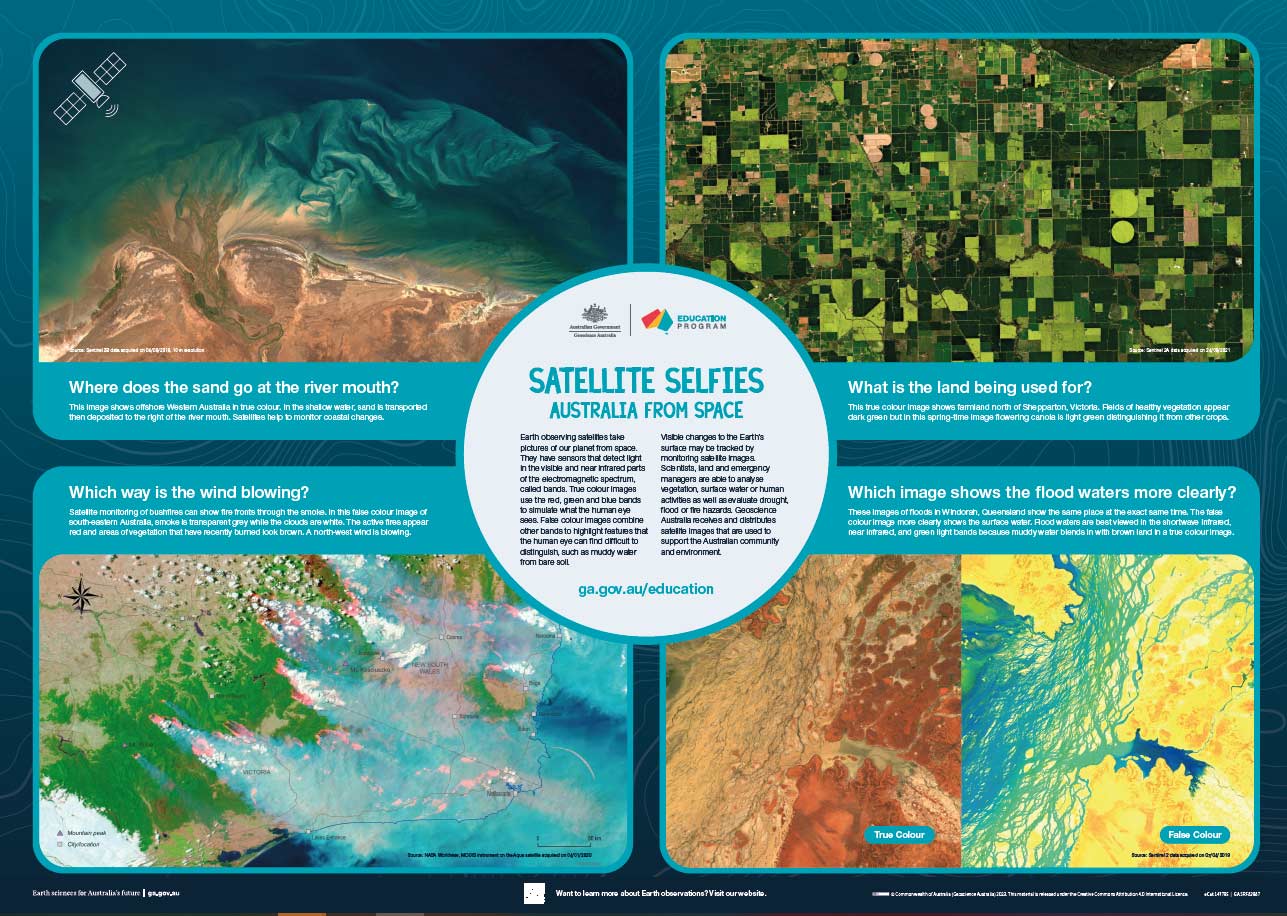
Satellite Selfies: Australia from Space Education Poster
Poster showing satellite imagery across Australia. Introduction to sensors and bands in the electromagnetic spectrum, true and false colour and applications of monitoring Earth observing satellite data.

Seafloor and land topography of Australia and surrounding region
This poster depicts the land and seafloor topography of Australia and its surrounds. It highlights many dramatic seafloor features associated with the continental margin and ocean basins around Australia and its external territories.

Discovering geological maps (legacy product)
Poster describing each of the elements on a geological map including symbols, grid references, cross-section, scale, geological reliability diagram and the geological time scale.
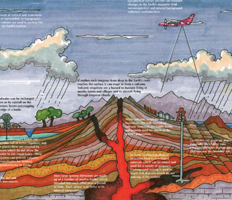
Theoretical geological cross section from the ocean through a mountain range to inland plains.

Earth observations: satellites over Australia
Poster showing a satellite image of each state and highlighting different uses of satellite imagery, particularly related to natural hazards.

Canberra firestorm January 2003
Satellite image showing burnt land and the fire front during the 2003 Canberra bushfires.

Satellite image of Victoria bushfires 2009
Satellite image of land cover across Victoria during the 2009 bushfires.
Student Activities

Analyse a map and consider potential impacts of a volcanic eruption.
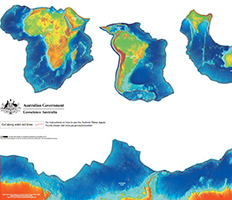
Solve the puzzle of plate tectonics with this world map that shows the edges of the major tectonic plates.
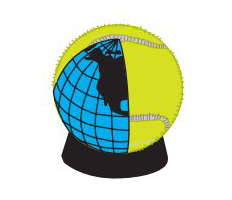
Plate tectonics cut-out on a tennis ball
Create a tectonics plate model using this easy to print A4 model. This colour model is ready to cut out and assemble on a tennis ball.

Plate tectonics cut-out on a basketbal
Create a tectonics plate model using this model which fits on a basketball.
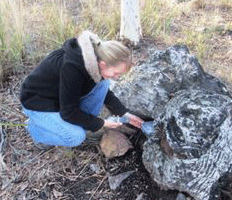
Explore these spatial activity ideas and discover the fun family activity of geocaching.

Interactive quiz using satellite images of Australian capital cities.
Further information

Dimensions of States and Territories, Australia compared to other countries, border lengths.

Information about elevation, water bodies, significant rocks, river, islands, waterfalls and deserts.

Print 1:50 000, 1:100 000, 1:250 000 and 1:1 million scale Australian topographic maps.

Four part wall map (2m x 1.7m), reference maps (1:5 million and 1:10 million), Asia-Pacific region map.

Allows you to calculate the distance between two places in Australia.

ESRI Australia classroom learning materials
Explore GIS, spatial thinking and mapping with these ESRI worksheets and lesson plans for secondary student (no special software required).

Updates are being made to the system that underlies Australia’s location information. The changes will bring Australia’s national latitude and longitude coordinates into line with global satellite positioning systems, enabling smartphones and other positioning technologies to accurately locate features marked on our maps. This video explains why this update is so important.
Australian Curriculum links
Year 4
HASS > Inquiry and Skills > Locate and collect information and data from different sources, including observations (ACHASSI074)
Year 5
HASS > Inquiry and Skills > Locate and collect relevant information and data from primary sources and secondary sources (ACHASSI095) > Organise and represent data in a range of formats including tables, graphs and large- and small-scale maps, using discipline-appropriate conventions (ACHASSI096)
Year 6
HASS > Inquiry and Skills >Organise and represent data in a range of formats including tables, graphs and large- and small-scale maps, using discipline-appropriate conventions (ACHASSI124)
Year 7
Science > Science Inquiry Skills > Construct and use a range of representations, including graphs, keys and models to represent and analyse patterns or relationships in data using digital technologies as appropriate (ACSIS129)
Geography > Knowledge and Understanding > Unit 1: Water in the world > The quantity and variability of Australia’s water resources compared with other continents (ACHGK039)
Geography > Inquiry Skills > Represent spatial distribution of different types of geographical phenomena by constructing appropriate maps at different scales that conform to cartographic conventions, using spatial technologies as appropriate (ACHGS050)
Year 8
Geography > Inquiry Skills > Represent spatial distribution of different types of geographical phenomena by constructing appropriate maps at different scales that conform to cartographic conventions, using spatial technologies as appropriate (ACHGS058)
Year 9
Science > Science as a Human Endeavour > Advances in scientific understanding often rely on technological advances and are often linked to scientific discoveries (ACSHE158)
Geography > Inquiry Skills > Represent spatial distribution of geographical phenomena by constructing special purpose maps that conform to cartographic conventions, using spatial technologies as appropriate (ACHGS066) > Identify how geographical information systems (GIS) might be used to analyse geographical data and make predictions (ACHGS069)
Year 10
Geography > Inquiry Skills > Represent spatial distribution of geographical phenomena by constructing special purpose maps that conform to cartographic conventions, using spatial technologies as appropriate (ACHGS075) > Identify how geographical information systems (GIS) might be used to analyse geographical data and make predictions (ACHGS078)
Senior Secondary
Geography > Unit 1: Natural and ecological hazards > The role of spatial technologies in the study of natural and ecological hazards (ACHGE015)
Geography > Unit 3: Land cover transformations > The identification and classification of land cover change using remotely sensed images and aerial photographs (ACHGE065) > The interpretation of data sourced from spatial technologies and fieldwork to explain the nature, rate, extent and consequences of land cover change (ACHGE066) >> Methods of projecting changes in land cover using spatial modelling, incorporating both environmental and socioeconomic variables. (ACHGE069)
Geography > Unit 4: Global transformations > For a mineral ore or fossil-based energy resource investigate the changes occurring in the spatial distribution of its production and consumption, and the geographical factors responsible for these changes (ACHGE103)






